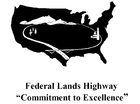Indian Reservation Roads Program
The Indian Reservation Roads Program (IRR) is part of the Bureau of Indian Affairs (BIA) and is meant to meet the transportation needs of American Indians in the United States, American Indian tribes, and Alaska Natives.[1] These roads, also known as BIA Roads are given to tribes by providing funds for planning, designing, construction, and maintenance activities.[1]
 Federal Lands Highway Program | |
| Agency overview | |
|---|---|
| Headquarters | Washington, DC |
| Website | http://flh.fhwa.dot.gov/programs/irr |
The program is jointly administered by the Federal Lands Highway Program and the BIA.[1] These roads are public that provide access to and within Indian reservations, Indian trust land, restricted Indian land, and Alaska native villages.[1] Approximately 29,000 miles (47,000 km) are under the jurisdiction of the BIA and tribes and another 73,000 miles (117,000 km) are under State and local ownership.[2]
The authorizing legislation is the highway authorization act (currently the Safe, Accountable, Flexible and Efficient Transportation Equity Act – A Legacy for Users (SAFETEA-LU)) and codified in Title 23 U.S.C. and 25 C.F.R. Part 170.[2]
The IRR program funds can be used for any type of Title 23 transportation project providing access to or within Federal or Indian lands and may be used for the State/local matching share for apportioned Federal-aid Highway Funds.[2]
List of roads
- BIA Route 1
- BIA Route 3
- BIA Route 6
- BIA Route 8
- BIA Route 14
- BIA Route 15
- BIA Route 18
- BIA Route 41
- BIA Route 42
- BIA Route 60
- BIA Route 62
- BIA Route 68
- BIA Route 91
- BIA Route 125
- BIA Route 170
- BIA Route 221
- BIA Route 6660
- BIA Route 6710
- BIA Route N12
- BIA Route N20
See also

References
- FLH > Programs > Indian Reservation Roads (IRR)
- "Indian Reservation Roads Inventory (IRR)". Office of Indian Services, Bureau of Indian Affairs. Archived from the original on 14 September 2015. Retrieved 17 July 2012.
- This article incorporates public domain material from dot.gov